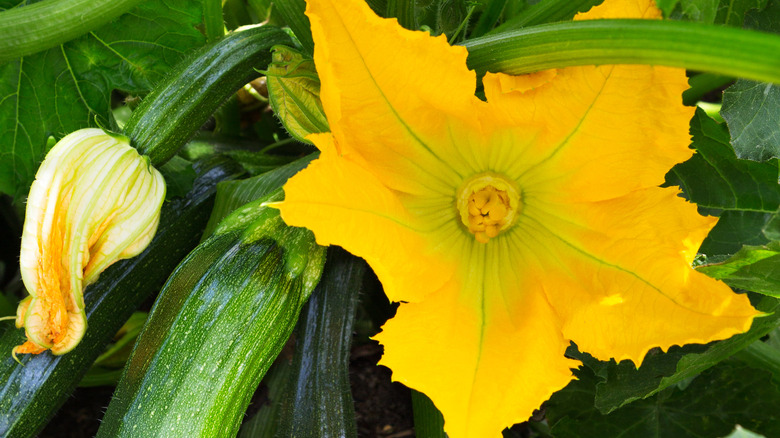Why You Should Only Cook Male Squash Blossoms
Squash blossoms are a delicacy, whether they're eaten raw, sautéed, or deep fried. Most commonly found at local farmer's markets and high-end food stores, the golden-orange to bright yellow colored flowers are a signature in Italian households (via The Spruce Eats). Plucked straight from summer and winter squash plants (via Parade), their flavor tastes subtly like squash with a delicate, velvety smooth texture make it incredibly versatile. From quesadillas to pasta, and salads to frittatas, squash blossoms add an ode to summer to any spread.
Squash blossom's short summer season makes them a sought after item at local farmer's markets that can be difficult to get your hands on. Plus, they're rarely found at grocery stores; their delicate nature makes them highly perishable and difficult to transport. For this reason, The Spruce Eats says the best way to maintain a consistent, quality supply is to grow your own — but there's an important note to take before you start picking them. For the love of your squash, keep your trimmers away from the female blossoms.
The birds, the bees, and the squash
According to Gardening Know How, all types of squash plants grow male and female blossoms together on the same vines. Without both of them, and a few bees and other pollinators to cross between the two, your squash yield would quickly dissipate into nothing. That's why it's so important to ensure that you don't harvest the female blossoms, as they're the only ones that actually produce squash (via The Spruce Eats). You should also always leave a few male blossoms as well to maintain a balance, as they're needed to help pollinate the females.
But, how do you tell the difference between a male and female squash blossom? Gardening Know How says that the female blossoms tend to grow in the center of the plant, with a small swelling, or pistil, at the base of the flower. This is the blossom's ovary, and will eventually grow into a beautiful squash. Male blossoms don't have this swelling, and tend to grow in higher numbers, with tall thin stalks that grow all across the plant. So, by maintaining a balance and saving your female blossoms, your squash will be able to reproduce. This means you'll have an abundance of squash, and squash blossoms, to enjoy all season long.

